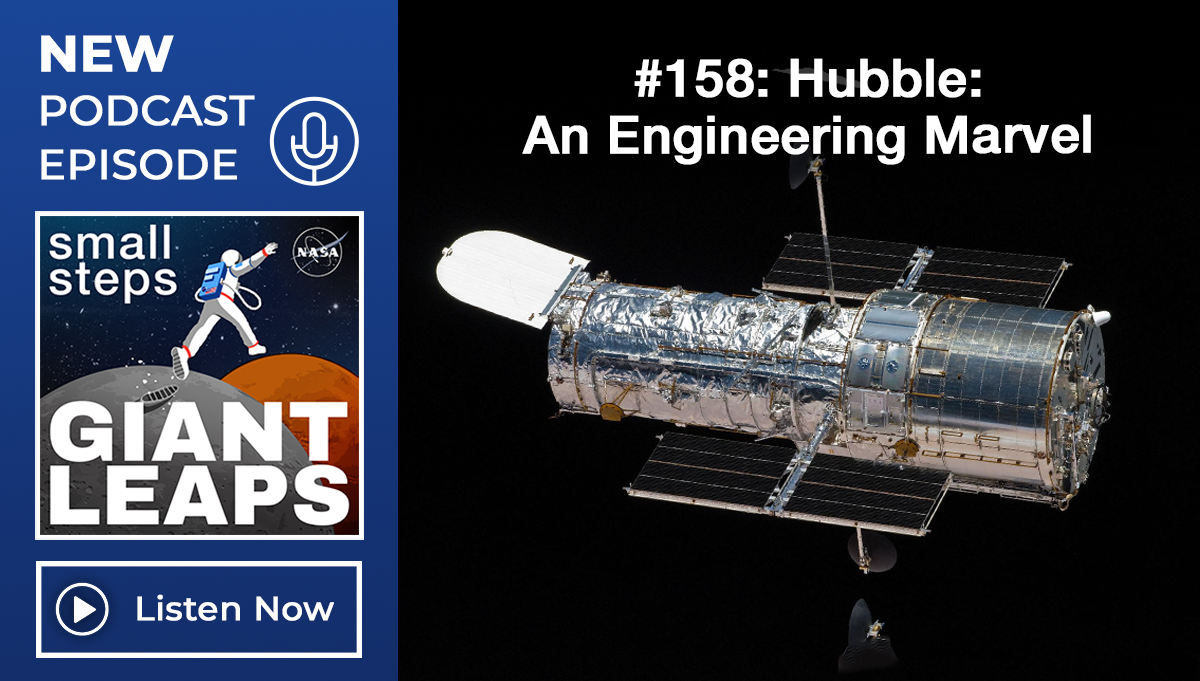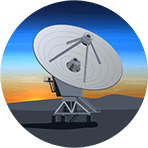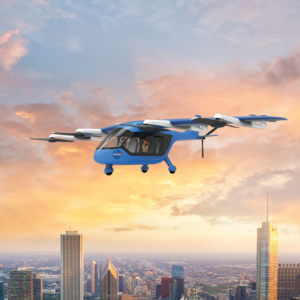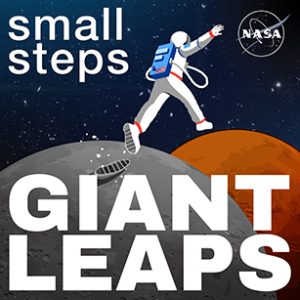Flying air taxis? NASA is working on it.
What will the future of air travel look like? NASA’s Air Mobility Pathfinders Project is tackling that question, developing new technologies to make aviation more efficient, sustainable, and accessible. From advanced air traffic management to electric and autonomous flight, this episode with Karen Cate, project manager, explores how NASA is shaping the next era of mobility in the skies.
In this episode, you’ll learn about:
- Use cases for urban air taxis
- How NASA works with the Federal Aviation Administration
- Current challenges in the National Airspace

NASA/Brandon Torres Navarette
Karen Cate is the project manager for NASA’s Air Mobility Pathfinders project. She previously served as deputy project manager of NASA’s Advanced Air Mobility project, and as deputy branch chief at NASA’s Aerospace Simulation Research and Development Branch. She was a member of the Urban Air Mobility Coordination and Assessment Team and she was involved in Air Traffic Management (ATM) research for more than 30 years. Her focus was four-dimensional aircraft trajectory prediction for air traffic management automation.
Cate was software manager for the Center Terminal Radar Approach Control Automation System and helped develop processes for transferring NASA prototype software systems to the Federal Aviation Administration for deployment. She was technical lead for the Interoperability sub-project within the Airspace Systems project, which focused on the integration of different ATM systems. She served as the deputy project manager for the Ames Research Center in California’s Silicon Valley for the Unmanned Aircraft System in the National Airspace project.
Cate has an aerospace engineering degree from the Massachusetts Institute of Technology. In her spare time, Cate enjoys being a hockey mom and doing escape rooms and puzzle games with her family.
Resources
Air Mobility Pathfinders Project
Advanced Air Mobility Mission
Airspace Operations and Safety Program
Aeronautics Research Mission Directorate
Courses
APPEL Virtual PM Challenge (On Demand)
Communicating Technical Issues (APPEL-vCTI)
Foundations of Aerospace at NASA (APPEL-vFOU)
Transcript
Andres Almeida (Host): Welcome to Small Steps, Giant Leaps, your NASA APPEL Knowledge Services podcast where we dive into the lessons learned and real-life experiences of NASA’s technical workforce. I’m your host, Andres Almeida.
What if you could use an app on your phone to call up an air taxi to take you from one side of town to the other? NASA’s Air Mobility Pathfinders Project, or AMP, is working on it.
The vision for AMP is to map out a safe, accessible, and affordable new air transportation system alongside industry partners, community partners, and the Federal Aviation Administration. Once developed, passengers and cargo will travel on-demand in electric, automated aircraft across town, between neighboring cities, or even to remote locations for rescue operations. We’re here with Karen Cate, project manager out of NASA’s Ames Research Center in Silicon Valley, to discuss the future of AMP and some of the challenges she and her team are looking at.
Hi, Karen, thanks for being here today.
Karen Cate: How’s it going, Andres?
Host: Pretty well! We’re happy you’re here.
Cate: Really excited about having a chance to talk to you about the wonderful world about Air Mobility Pathfinders and Urban Air Mobility.
Host: I’m excited too, and I’d love to know, can you give us an overview of the Air Mobility Pathfinders project?
Cate: Sure! Urban Air Mobility will enable people to use air taxis to get them more to where they need to go. We’re in this really exciting time where new technologies in an aircraft in airspace are going to allow us to go vertical when it comes to delivering people and cargo where they want to go. What NASA’s goal is is to deliver data that’s going to help industry develop the concept of electric air taxis and also working with the Federal Aviation Administration to figure out: How do we safely integrate these vehicles into the national airspace?
And what Urban Air Mobility, known as UAM, is going to do is allow people to use air taxis, you know, in situations where previously they might have taken a car.
Currently, there are existing commercial operations using conventional helicopters in cities like New York and LA, but there’s been always challenges to the growth of that industry, due to the cost of fuel, the noise that helicopters make. So now we’re looking at leveraging, you know, advancements in technology supporting alternative means of propulsion – like electric aircraft, hybrid aircraft – to make UAM really a viable option for travel.
And so, our project’s primary goal is to understand what this whole ecosystem might look like. You know, we currently have a thriving air transport system, you know. So, the question is, how do we introduce new entrants or new vehicles into the system while ensuring that we promote the safety that we’ve always had with air transportation.
So, if you think of the ecosystem as like a puzzle, you know, we have all these pieces that involve the aircraft, the operators, air traffic services, infrastructure and community. What AMP’s goal is to take these pieces and put them together, figuring out what is the, you know, what’s the critical data that needs to be exchanged so that way everyone can operate and have awareness and understand what the other actors are doing and what their constraints are.
We’re very much focused on understanding not only how the pieces you know that relate specifically to Urban Air Mobility fit together, but also how do we fit into the larger picture of all the other aircraft in the airspace, now that we’re looking at introducing drones for package delivery and existing commercial transportation. Our project is comprised of research and developers from all four of NASA’s aeronautics research centers. Experts from all across the country on all the different aspects of this problem, including the aircraft and aircraft operations, management of airspace, communications, and automation.
We’re leveraging this wide range of skill sets to help us understand how the ecosystem will fit together and making sure that we’re addressing and identifying, critical technologies that need to be developed to support this new ecosystem and as well as assuring safety but while trying to find efficiency and scalability so that we can meet the needs of the traveling public.
Host: This common trope I hear, this common theme growing up, even now, right, you always hear, “We were promised flying cars, flying air taxis,” and it seems like NASA’s working a little closer with the FAA to really make that a reality, but for practical reasons, right?
Cate: You know, people think of The Jetsons. That’s always been kind of our joke that, you know, well, when are we going to be the Jetsons? But there’s a lot of places where we can start introducing these type[s] of technologies that are kind of replacing, like existing uses of these types of aircraft.
One of the first implementations, I think we see, is, is public good missions. Like, for example, this will make it easier to do Life Flights. If you’ve got a[n] accident, remote location, you know, how can we quickly get medical personnel to the to the site? How could we get that person back to a hospital or appropriate facilities for treatment? These are uses that we can have for disaster response. This could be a way to get people out of impacted areas that have been impacted by some kind of natural disaster, to help try to relieve some of the congestion that you have when people have to evacuate an area.
Lots of uses, not just being able to get us from place to place, but, you know, but certainly that’s one of the major goals, is to help reduce congestion, help people move faster, you know, address issues like, well, how do you get from, how do you get from the last mile from the airport closer to your house? You know, maybe you don’t have to drive an hour anymore, after you’ve been sitting on a plane for a long period of time. You know, I think there’s going to be a lot of opportunities and uses for this, and understanding, how can we, how can we meet the needs of the people who will be using the system, but also figuring out how, you know, to do this safely and, and to be able to integrate it, but at the same time, give everyone the opportunity.
Host: Speaking of safety, you know, what kinds of technologies and innovations are you all exploring to enhance safety?
Cate: You know, one of the big challenges is that we have an air traffic system with an extreme focus on safety. And so, the question is, how do we introduce more aircraft into the system without straining the workload of the [air traffic] controllers? One of the major projects that we’re working to understand is a system called the provider services for UAM, and this is an ability to give the operators more control so that they will help supplement the existing air traffic system by managing their aircraft and working cooperatively with other providers by sharing critical intent information so that they can understand what the intent of their aircraft is and help with flow management and help with maintaining safe separation.
Host: So, what are some of the biggest challenges in integrating these new Air Mobility technologies? You touched upon congestion, right, and maybe straining air traffic controllers. But what else in the national airspace is there?
Cate: One of the, or one of the big challenges that they’re facing right now is, is a pilot shortage. So, there’s an increasing reliance, I think, on, you know, increasing levels of automation within the aircraft. We’re talking about, you know, areas with higher densities, so we have to account for, you know, things like noise, you know, making sure that what the patterns that the aircraft are flying — we can try to minimize the impact of noise, as well as having vehicles themselves that are much lower volumes.
Host: NASA collaborates with, as you mentioned, industry and government agencies. How do these partnerships really shape the research and the development process? Any examples you can provide?
Cate: We are very much responsive to working with industry and other government agencies, specifically the FAA. Most of them are focused on initial entry to service, where they’re looking at operations that are going to be governed by existing flight rules and procedures.
Where both industry and the FAA have asked NASA to focus on, is kind of the next stage where operations are starting to scale to the point where roles and responsibilities may have to change, in one of the cases of that is increasingly automated vehicles, and where your pilot may not be on board, they may be remote, or it may be completely automated aircraft. So that’s going to change the roles and responsibilities.
And what NASA is uniquely positioned to do is inform what changes are going to might need to be made, as well as identifying critical technologies to build a system that always has an eye on scalability, about increasing operations, but always, always maintaining safety.
Host: So then, is it true that NASA’s work in this Air Mobility, does it impact the future of autonomous flight and air traffic management? Does NASA itself really influence air traffic management and autonomous flight?
Cate: What we’re doing is we’re working with the FAA to explore, you know, how air traffic management may need to evolve going forward.
And for example, the FAA has developed a concept of operations for UAM. One of the areas that they’ve introduced is this concept, as I mentioned earlier, about giving fleet operators more insight and an ability to enhance traditional air traffic services through these highly automated cooperative operations. We call this concept xTM, Extensible Traffic Management, and it’s a way to leverage shared intent information or flow and separation management.
It also allows for third party services, so services brought by industry for doing some of these functions that will and will allow them to bring these services in, so that way, if a particular region or area needs services that address their specific situation. We can help bring these services in that they’ll have standard interfaces and be able to share information with the parties that are operating in that area.
We’ve actually manifested this concept in our UTM project, which is UAS traffic management, dealing with small drones. That project really matured these types of capabilities for small drones and package delivery. So, we’re leveraging the lessons learned from that project, as well as tools for separation management that were developed in another project called UAS in the NAS to help define requirements for cooperative separation management and, you know, really be able to build on the system towards being able to have more capabilities in terms of introducing other new entrants into our system.
Host: What I find interesting is that you mentioned knowledge sharing within NASA and with other agencies. Can you share any specific lessons learned throughout this project.
Cate: One of the things that has been really helpful to our project is that, like I said, we were building on the work that was done for, you know, small UAS and which, which gave us a lot of insight into, you know, some of the issues and challenges of working with fully autonomous systems, as well as understanding what challenges you may have when you have a pilot who is not on board.
One of the other things lessons that we’ve really learned is that we really have to consider the entire ecosystem. It’s very easy to focus on just one part of the ecosystem, because either you have expertise in that you know, or that is what is as an industry member, that is what you are providing, but really being able to understand how you fit into the system, and what are specific challenges and what are the assumptions people are making about, you know, what role and responsibility other actors in the system have. It’s been very critical to have that kind of top-down view to say, “Okay, really how are these pieces all going to fit together?”
We can’t just look at one piece, you know, maybe we’re not able to look at every piece in extreme detail, but some of the critical challenges we face are oftentimes because everyone’s making that assumption while someone else is responsible for this function, or someone else is going to be doing this function. And making sure that everyone is synchronized and on the same page is really critical. And that everyone understands what their role and their responsibility are.
Host: For those excited about the future of Air Mobility, what should they be looking forward to in the coming years?
Cate: What people will be excited about is, is seeing the impact of what urban air mobility can do for them.
There are definitely a lot of use cases where people will really, can see potentially a difference in their lives, even if, even if they don’t use the service because one of the use cases that they’re looking at is, what happens when you have a surge event? You know, you’ve got, you’ve got a big football game, you’ve got a, you’ve got something that draws many, many people to one area. Can we use urban air mobility to help people move efficiently to these large events without impacting the existing neighborhoods.
Like I said, they’re going to be, you know, uses for this where this is going to be for the public good, like helping out in the case of disaster recovery, or being able to transport goods, services, or personnel to areas where they’re going to be critically needed in a in a much more efficient fashion. We’re really excited about it, and I think they’re going to see changes in the way we move, changes in the way we, we get from place to place, giving more access to places that might otherwise be somewhat remote. All these are changes that I think will impact the public in a very, very positive way.
Cate: I wonder if you or your team, hear stories of people being like, well, I don’t know if I’m fully confident in autonomous anything right now.
Host: Yeah, you know, I think there’s definitely, there is a generational reaction to it. In some ways, there are people who are a little bit more hesitant about it, but then I think there’s a generation coming up that have become very used to technology being part of their everyday lives. And so there, I think there’s a lot of people who are very excited about it.
The one thing I have seen just in talking to people in general, is that they’re really excited to see how this could change how they go about moving. Whenever I just casually talk to people about it, they’re very excited to see how could they use this to get to the airport? How can they use this to avoid rush hour traffic? And definitely, I think there’s this embracing of automation when they realize, you know, how many things they do with their car right now that they’re, they’re really using automation to tell them or to help them with a function that would otherwise be challenging for them.
So, I think as, as these things slowly become more and more common in our everyday lives, the more people are willing to embrace this
I remember back in the day there was a MythBusters episode, which was actually filmed here at NASA Ames. They were trying to figure out, could a passenger fly the aircraft and land the aircraft, you know, which is a classic movie trope. And when it was all over, they said, “Well, really, all you have to do is throw the switch and pretty much the aircraft will land itself.” But we do rely on the pilot in case of any contingencies. And people don’t always see that, but there’s very much reliance on technology that, you know, and making sure that we have, we still have that ability to have to understand that there will still be humans that can intervene, I think, will help a lot with the acceptance.
Host: What do you consider to be your giant leap?
Cate: Our giant leap will be when someone can basically pick up their phone and be able to say, “Hey, I need to get to the airport at this time,” and be able to schedule their air taxi that will get them to where they need to go on time. It’s a function that will be available to anyone. To be an affordable option that will potentially save them time and money to get them where they need to go.
So right now, we’re taking those small steps, you know, in slowly introducing these different opportunities. Starting off, it’s just going to be set schedules. People will be going from fixed locations. Looking forward to when we see this opportunity to fly multiple places to get people where they need to go.
Host: Well, I can’t wait. I’m curious about yourself too, though. What do you consider to be your personal giant leap, careerwise?
Cate: I think my personal giant leap was becoming a project manager, to really be able to take control of a piece of work that I find really exciting, to really be able to influence the ability to make such a change in people’s daily lives, in that we are really expanding their opportunities to go places, to be able to move in, in different ways that they never expected that they would, or to make this type of travel more, more commonplace and to really positively impact people’s lives.
Previously, I worked on a project that was part of the Air Traffic Modernization Program, and we were building a tool that would help controllers manage and reduce delays going into airports. And when I told people, it’s like, well, yeah, this tool may only save you a couple minutes, but if you think about the overall system, you know, if every single aircraft saves a couple minutes, how much fuel is that going to save the airlines? Which comes right back to the customer, because that helps reduce their operating costs. And that will come back and affect consumers’ ticket prices. You know, a few minutes, you know, maybe that helps you make your next connection, and it can have a big impact on your whole travel experience. So, those are small steps, but they can, they can have those giant leaps. And I’m hoping that UAM will do the same.
Host: Karen, thank you so much for your time.
Cate: You’re welcome. I’m very excited about this project and where we’re going to go with the future of air transportation.
Host: That’s it for this episode of Small Steps, Giant Leaps. For more on Karen Cate and the topics we discussed today, visit our resource page at appel.nasa.gov. That’s A-P-P-E-L dot nasa dot gov. And don’t forget to check out our other podcasts like Houston, We have a Podcast, Curious Universe and Universo Curioso de la NASA. Thanks for listening.
Outro: 3-2-1. This is an official NASA podcast.







